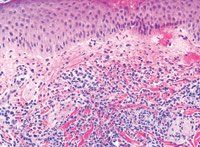A teen with persistent painful papules and plaques
Teen with painful papules and plaques is diagnosed with Sweet's Syndrome
THE CASE

DIAGNOSIS:
Sweet's syndrome, also known as acute febrile neutrophilic dermatosis, is a reaction pattern in the skin characterized by a neutrophilic infiltrate. This may present in several forms, including:1
Classical Sweet's syndrome (CSS) is often preceded by a streptococcal or viral upper respiratory tract infection, and is occasionally associated with inflammatory bowel disease or pregnancy.
Malignancy-associated Sweet's syndrome (MASS) occurs in the context of a patient with an occult solid tumor or a hematologic dyscrasia, most commonly acute myeloid leukemia.
Drug-induced Sweet's syndrome (DISS) is most commonly triggered by granulocyte colony stimulating factor (GCSF) or the antibiotic sulfamethoxazole-trimethoprim.2,3
CLINICAL FINDINGS

DIFFERENTIAL DIAGNOSIS OF NODULAR RASH
Erythema nodosum is another reactive erythema that may also be triggered by infections, drugs, inflammatory diseases, lymphomas, and pregnancy. Deep-seated painful, erythematous to violaceous nodules develop typically on the anterior surface of both legs, and usually resolve in two to eight weeks without scarring. The eruption of Sweet's syndrome can be clinically and histologically distinguished from erythema nodosum, which is an inflammatory disorder involving fat.
Disseminated gonococcemia begins with papules and vesicles, which may occasionally evolve to pustules with a necrotic base. It may also be associated with fever and polyarthritis. A Gram stain obtained after unroofing a pustule reveals the organism.
Rheumatoid neutrophilic dermatitis (RND) occurs most frequently in women with seropositive rheumatoid arthritis (RA). The typical eruption consists of erythematous, urticarial-like papules, plaques or nodules less than two centimeters in diameter. Unlike Sweet's syndrome, lesions in RND usually clear with aggressive treatment of the RA. Moreover, these patients do not present with fever or other constitutional symptoms.
Recognize & Refer: Hemangiomas in pediatrics
July 17th 2019Contemporary Pediatrics sits down exclusively with Sheila Fallon Friedlander, MD, a professor dermatology and pediatrics, to discuss the one key condition for which she believes community pediatricians should be especially aware-hemangiomas.